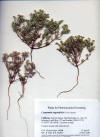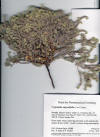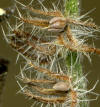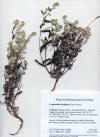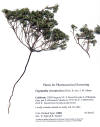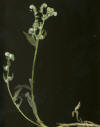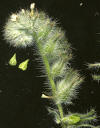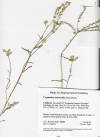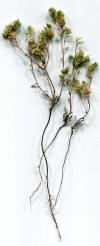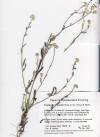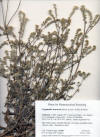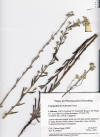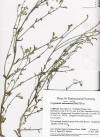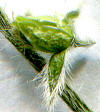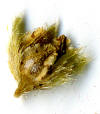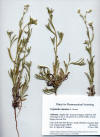|
The genus Cryptantha is indicated in the Intermountain Flora Vol. 4: (Cronquist et al. 1984) to comprise 150 New World species with two thirds of them found in western North America. Most of the annual species belong to Sec. Krynitzkia in which the species are supposedly “well-defined.” However, this not always the case. In the California Jepson Manual, C. angustifolia in the key is indicated to have “nutlets” with rounded margins, whereas in Cronquist et al (1984) and also Abrams' Illustrated Flora of the Pacific States (1951), the “Angustifoliae” (5 spp.) is defined as having “sharply angled” mercarps (“nutlets”). Species identification generally requires mature mericarps, while a species may also vary in color and in development of its inflorescence. In C. angustifolia, a common annual species in the California Mohave and Sonoran deserts, the inflorescence elongates as plants mature. The flowers initially appear in tight hemispherical clusters and elongate into “helicoid spikes” as plants mature. Additionally, plants may appear dark green or lighter yellowish-green in color. This species is also generally recognized by the sublinear subteretiform leaves that are often curved, and irritating hairs on the plant, especially on leaves and flowers. This in contrast to another common annual species, C. maritima, which can be recognized by the relatively smaller flower and more bristly stems. The identification for the photo of C. inaequata is based on the illustration in Abrams (1951). This is treated as a synonym of C. angustifolia by Cronquist et al. (1984), while it is not mentioned in the Jepson Manual. But I have recognized it by its flat leaves in contrast to the teretiform leaves of C. angustifolia.
|
|||
 Cryptantha
abata |
Cryptantha angustifolia |
Cryptantha angustifolia |
Cryptantha angustifolia
|
|
Cryptantha angustifolia
|
Cryptantha angustifolia |
Cryptantha angustifolia |
Cryptantha angustifolia
(right), Cryptantha maritima
|
|
Cryptantha angustifolia
|
Cryptantha angustifolia
|
Cryptantha barbigera
|
Cryptantha barbigera |
|
Cryptantha capitata |
Cryptantha circumscissa
|
Cryptantha circumscissa |
Cryptantha circumscissa
|
|
Cryptantha confertiflora
|
Cryptantha confertiflora
|
||
|
Cryptantha flava |
Cryptantha flavoculata
|
Cryptantha flavoculata |
  Cryptantha
aff. flavoculata |
|
Cryptantha glomeriflora North End of Owens Valley, just north of Bishop, CA. May 2006
|
Cryptantha holoptera Imperial Co., Palo Verde Mountains, Spjut 16236, April 2008. |
Cryptantha inequata. Mericarps generally 3, or sometimes 4, similar to C. barbigera in topography, flowers smaller, stems decumbent, not erect. San Bernardino Co., CA, Kelbaker Rd, Mar 2008
|
|
|
Cryptantha intermedia
|
Cryptantha maritima |
Cryptantha maritima
|
Cryptantha micrantha
|
|
Cryptantha muricata
|
Cryptantha muricata
|
Cryptantha
cf muricata
|
|
|
Cryptantha muricata
|
Cryptantha nevadensis |
Cryptantha oxygona |
|
|
Cryptantha pterocarya
|
Cryptantha pterocarya
|
Cryptantha racemosa
|
Cryptantha simulans |
Cryptantha cf torreyana California: Kern Co., CNPS Chapter field trip, Greenhorn Mts., Rancheria Rd., 25 May 2013
. |
Cryptantha tumulosa |
Cryptantha utahensis |
Cryptantha virginensis |
|
Trees and Shrubs of Kern County (Jan 2013) Oreocarya confertiflora Greene 1896 [Cryptantha confertiflora (Greene) Payson 1927]. Mojave popcorn flower. Woody and leafy near base, leaves simple, erect, narrowly elliptical, more than 4× longer than wide, densely hairy, often silvery; flowers Apr–Jun, the flower stems several or more, erect, bearing many yellow flowers clustered near the tips. Primarily centered in the Mojave Desert, extending into the Great Basin Desert, usually above the creosote belt, on rocky limestone soils, southern California, Nevada, Utah and northern Arizona. Type from Cushenberry Springs, desert slopes of the San Bernardino Mts., CA. Kern Co.: Erskine Creek, Mt. Laura in the Piute Mts. (CCH: Purpus, 1897 and 1898); this collection explicitly excluded from the flora by Twisselmann, but the species subsequently recollected on Mt. Laura in the Piute Mts. (Moe; CCH specimens, Shevock Apr 1984; York & Carter May 1996), and also reported from Long Canyon (Keeler-Wolf 1990). Recent molecular studies (Hasenstab-Lehman & Simpson 2012) place the species in the genus Oreocarya where it had been first described and also classified earlier by Abrams; subsequently treated in Cryptantha (Munz, Intermountain Flora, JM1, JM2). |
|||
